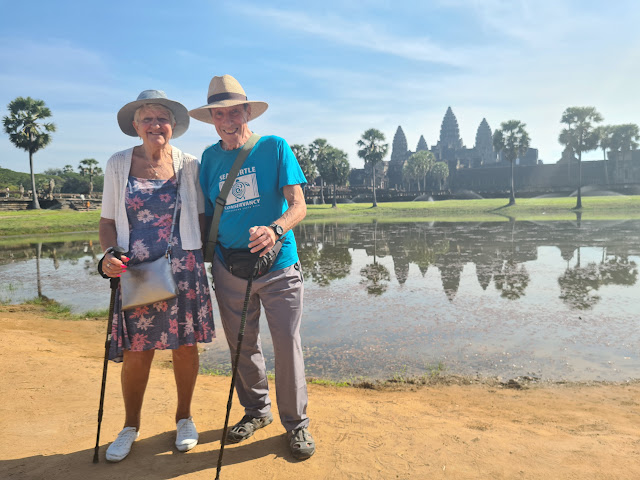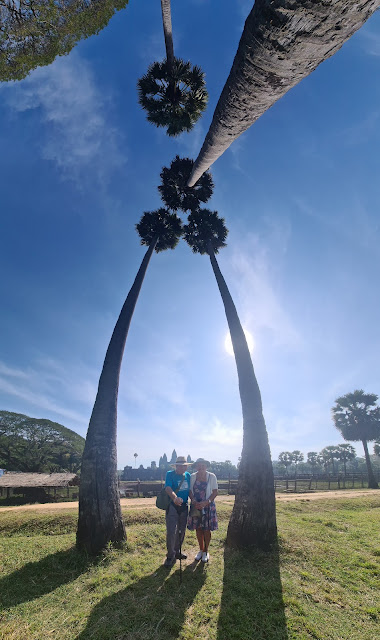
Lucky is also something of a photographer so you will see both Helen and me appearing in several of the pictures. Before Covid Angkor Wat was attracting 2 million visitors per year. Numbers completely collapsed and Lucky ended up working on a building site for $5 a day. There was no government help.
The entire building is covered with these bas relief carvings. They are absolutely fascinating. They record history, tell the stories of the gods and record day to day living. Below we can see Queens being looked after.
The monkey god hanuman is around to protect
Symmetry rules in Angkor Wat. It was built planned on rotational symmetry order four, so it has a centre point where the four axes meet, and between our heads is it.
Construction methods here are totally different from stone constructions in the West. There blocks of stone are dressed then mortared together. Windows and doors are built around a former, stone by stone. Here blocks of stone are locked together with polished surfaces to ensure a tight fit. Any window or door is then carved out from the existing wall. This requires very precise work and no second chance if it goes wrong. The same can be said of the bas relief carvings. So the window and door frames were made of wood, but the rest one solid mass of stone. This limestone was quarried several kilometres away and transported by water.
More bas relief carvings, this time you can see everybody pulling on a rope or beam. This is a much used symbol of togetherness and cooperation. Something we could do with a bit more of in the UK. The minutiae of life and death in C12 is recorded by the carvers in fascinating detail. This is reminiscent of the medieval wood carving on the choir stalls in Boston stump or, for those who know it the Bayeux Tapestry.
We have now moved on to the next temple called Ta Prohm. Unfortunately this 800 year old building which spent much of its life "lost" in the jungle is now better known because of a 2001 film and everybody refers to it as the "Tomb Raiders" Temple. The way the undergrowth appears to be encasing the building is fascinating and very photogenic. Above us is a silver cotton tree.
Something equally dramatic, we are sitting under a Parasite tree. This tree will use another different species to climb up to the light and to gain sustenance. This will eventually lead to the death of the host tree.
Many people see a snake in this tree. Me, I can see snakes everywhere
More silver cotton trees but not a Lara Croft in sight!
Time to break for lunch and you have the chance to meet Miguel. He is a care worker who is employed privately and is currently taking a break to travel. The meal that he is eating is a kind of fish stew served up in a hollowed out coconut so it looks like a chowder. I made the same choice.
This is the gate to the city of Angkor Thom. In 1177 Angkor Wat and its city was sacked by the Chams, traditional enemies of the Khmer. In late C12/early C13 the empire was restored by a new King, Jayavarman Vll and he built Angkor Thom and his temple Bayon. This one was dedicated to Buddha because the Hindu gods had clearly failed him.
It's the serenely smiling faces of Buddha facing in four directions that are the constant and enlightening feature.
This is another bas relief carving telling the story of how the temple came into being. You can see the King on his elephant and his troops as they march into battle against the Chams. By the C12 the Chams had adopted Islam as their religion. The different ethnic groupings are clearly discernible in the carvings.
Finally the three punters and Lucky together. Although this is the only picture of Lucky on the blog, I hope that he sees it and reads this special thanks for providing us with such an enjoyable and informative day. This blog I dedicate to you, Lucky and to you Miguel, enjoy Lucky's luck for the rest of your travels.

















No comments:
Post a Comment